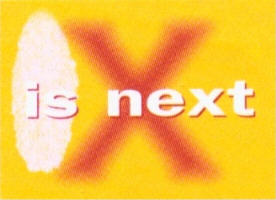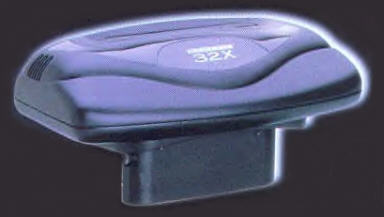
"500,000 Units Sold, 10 Million Unsatisfied Customers"

"500,000 Units Sold, 10 Million Unsatisfied Customers"
In the video gaming world, the words "Sega 32x" are synonymous with failure... and the shockingly rapid sinking of the 32x add-on console was the beginning of the end for Sega as a hardware manufacturer. Never before has a system risen so high and fallen so far in such a short time, and the repercussions of its demise spelled the doom of the two high profile consoles that followed it. The 32x is a gaming laughingstock, ignored by collectors and abhorred by enthusiasts.
Does the 32x deserve the amount of harsh criticism that it receives? In a word, probably. The technology is flawed, many of its games are mediocre, and Sega disowned and tried to forget its poor bastard child long ago. But regardless of its history and lineage, the 32x represents innovation, the kind of "thinking out loud" that we have come to expect from Sega.
To understand and appreciate the Sega 32x, you must first understand and appreciate the Sega Genesis (called the Mega Drive everywhere else in the world) and its "true" successor, the Sega Saturn. After a rather brief and relatively unsuccessful attempt to break into the lucrative videogame industry with the 8-bit Sega Master System, Sega decided to try its luck again, introducing the 16-bit Genesis to the American marketplace in 1989. The Genesis and its only other 16-bit competition, the Turbo Grafx-16 (from NEC), initially sold poorly against the Nintendo Entertainment System (NES), an amazingly popular 8-bit console that had dominated the American market up to that point. Genesis sales started to pick up in the early 90’s, fueled by popular and critically acclaimed games like Sonic the Hedgehog and John Madden Football. By 1992, the Sega Genesis was outselling the newly released Super Nintendo Entertainment System (SNES) by a healthy margin, and the Turbo Grafx-16 was fading rapidly.

The Genesis console employs a speedy 16-bit CPU but, unlike the SNES, has little in the way of custom hardware features. The SNES has a relatively slow CPU and a complicated architecture, a design that initially led to problematic games that were often deemed inferior (slower) to their Genesis counterparts. Many enthusiasts viewed the Genesis as the “cooler” system, even though it had a weaker sound chip and a smaller color palette. Sales of the Genesis were strong in the States, and it looked like Sega would win the 16-bit console war. In 1992, Sega introduced a CD-ROM drive for the Genesis that featured a faster version of the MC6800 processor, as well as hardware scaling and rotation. Unfortunately, CD technology was still expensive to produce at that time. The $299 price tag, along with a series of amazingly poor "Full Motion Video" software, resulted in low sales and the first big spot on Sega’s reputation.
Eventually, developers
came to grips with complex SNES hardware and began to produce games that
took advantage of the Nintendo’s superior sound and graphics. Nintendo
started to employ a custom processing chip (called the FX chip) in some
of their cartridges (Starfox, FX Racer, Doom), resulting
impressive game with rudimentary 3-D graphics. Sega introduced their own
chip-enhanced cartridge for the Genesis in the form of Virtua Racing,
but decided that the special SVP (Super Virtual Play) processor was simply
too expensive to use on a large scale (Virtua Racing retailed
for a whopping $100, the most expensive mass-produced domestic cartridge
ever made.) Even though the Genesis was still doing very well and outselling
the SNES, Sega looked to the future and began to plan their next-generation
console, tentatively called "Saturn".
 |
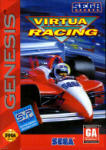 |
|
|
|
Some of the biggest sellers for the Genesis had been 2-dimentional games like Sonic the Hedgehog, Mortal Kombat, and the Street Fighter series (a 2-dimensional game has characters and backgrounds that have height and width but not depth, unlike games that use polygons to create a 3-D world.) Sega assumed that the market would continue to clamor for 2-D games and designed a console with impressive sprite manipulation and scaling capabilities. Sega did, however, also want to be able to replicate the polygonal graphics of arcade hits like Virtua Racing and Virtua Fighter, so their new console needed to have respectable 3-D capabilities as well. Sega wanted to keep manufacturing costs low, so they decided to use mass-produced, off the shelf components in their new console.
Sega began to get reports regarding the design and capabilities of consoles from their competitors, including Nintendo, 3DO, Atari, and the newcomer, Sony. Sony’s original Playstation was actually a combination CD-ROM drive and 32-bit chipset for the SNES. Nintendo later cancelled the deal, leaving Sony to redesign the console and release it on its own. The Playstation was designed from the ground up as a system with excellent 3-D capabilities; it contains a custom processor specifically designed for 3-D applications, as well as a “geometry engine” chip capable of fast polygon calculations. The more Sega learned about their competition, the more they realized that their current console design for the Saturn was markedly underpowered. The decision was made to increase the power of the Sega console by adding additional graphics processors, as well as a high-end (and pricey) Yamaha sound chip. Sega even considered producing both the CD-based Saturn and a similar cartridge-based console, the Jupiter, at the same time to save money on CD-ROM drives. This idea was eventually scrapped when Sega realized it would be unwise to market a cartridge-based console that would be deemed inferior to its CD-based counterpart. Unfortunately, the final design for the Saturn was already much more complicated than Sega had hoped, and much more expensive to manufacture than the original "off the shelf" model. Game development for the Saturn was much slower and more difficult that it had been for the Genesis, causing further delays. By the time Sega’s next-generation machine was finished, it has gone from a relatively weak system to a powerful and flexible console with impressive 3-D capabilities and amazing 2-D power (the Saturn is actually much better at 2-D graphics than either the Playstation or the Nintendo 64.) Unfortunately, the convoluted chipset design meant that the machine was very difficult to program (a major flaw that would later come back to haunt Sega) as well as extremely expensive to manufacture. A suggested retail price of $400 was proposed, and Sega would still lose money on every Saturn they made. There was talk of pushing back the release date of the Saturn, and it was even rumored that the Saturn might not make it to the United States at all! Whatever the case, the Saturn was destined to debut at a very high retail price, and it would not be compatible with the Genesis or Sega CD (making the Saturn compatible with the earlier systems would have increased the cost of the console even more.) It was decided that the lucrative American market needed a less-expensive console to ween it off the Genesis and towards the Saturn, which lead to the birth of the 32x.

Sega
Saturn
The 32x system has a reputation as being "American". That is, an American design, an American machine, and a Sega of America failure. This is not really the case. In fact, the basic idea for the 32x actually came from Sega of Japan. It is reported that Sega of America was none too pleased with the assignment of designing the 32x hardware, but at least they were being included in what had been a Japan-only desision making process up to that point. Rather than design a new stand-alone console, it was decided that the hardware would operate in tandem with a stock Genesis/Mega Drive unit. Such a design offered several advantages, namely cheaper manufacturing costs and seemingly instant consumer acceptance. In theory, gamers would be happy to "upgrade" their existing systems rather than invest in a brand-new console. Several designs for the new machine were eventually proposed, including:
1. A simple add-on device that would contain a single CPU. Instead of putting an expensive CPU chip in every game (like Virtua Racing or Nintendo's FX games), the more powerful CPU would be a one-time-only purchase. This simplistic approach was rejected as being not powerful enough.
2. An add-on sporting twin 16-bit processors and an additional graphics chip, similar in design to some of Sega's arcade hardware.This approach was deemed too similar to the stock Genesis/Sega CD combo.
3. A more powerful upgrade that featured a true 32-bit CPU and better graphics capabilities. This design still didn't quite provide the necessary processing power.
4. A Sega of Japan design that featured twin 32-bit CPUs and a custom graphics chip. This variation was deemed to be the best choice, and eventually became the basis for the 32x.
It has been suggested that the Saturn console was originally concieved as being nothing more than a 32x chipset attached to a CD drive. This is incorrect. The Saturn project was initiated long before the 32x, and neither console is compatible with the other. They do share some basic similarities, though this is to be expected since both machines are Sega designs based on proven arcade hardware. The Saturn, unlike the Genesis, is a very complicated machine, and Sega may have hoped that a "training period" on the similar 32x hardware would better prepare developers for the programming hurdles they would face later when working on the Saturn. It is possible that the final 32x hardware was based on a very early Saturn design, but the released Saturn console is considerably more powerful than the 32x.
The 32x sits on top of the Genesis console, connecting to the Genesis through the cartridge port. The whole set-up looks odd, as the 32x is shaped a bit like a mushroom. A set of metal clips connect to the Genesis around the cartridge port, shielding the system from electromagnetic interference. The 32x employs two Hitachi SH2 processors (the Saturn uses two SH3 chips, and the Dreamcast uses a SH4) that can operate in tandem with the Genesis processors. If attached to a Sega CD, the entire configuration (32x, Genesis, and Sega CD) features two 32-bit SH2 chips, two 16-bit 68000 chips, and one 8-bit chip (the same CPU found in the Master System.) When properly connected (a chore that would later prove detrimental) the 32x can display 2-D and 3-D graphics on top of those provided by the Genesis. The number of available colors jumps to 32,768, and Sega advertised that the 32x is 40 times faster than the Genesis, with enhanced scaling and rotation capabilities, texture mapping, and processing power capable of producing 50,000 polygons per second. The 32x also adds two additional sound channels to the 12 already provided by the Genesis. 32x cartridges are the same size as Genesis cartridges, and both can be played through the 32x. The 32x serves as a simple connection device when used with Genesis cartridges and does not change or enhance Genesis games in any way, a fact that was lost on many consumers. The Genesis cannot play 32x games without the aid of the 32x, and plugging a 32x cartridge directly into a Genesis will simply result in a black screen. The 32x can also be utilized to play CD games with the aid of the Sega CD. If a CD is not designed for the 32x, then the unit will operate as normal with no assistance from the 32x.
SOA was enthusiastic about the chances of success for the 32x and began to market it aggressively to game developers. The Genesis had been a very sucessful and lucrative gaming platform, and a large number of developers expressed a keen interest in the 32x, including such market heavyweights as Konami, Capcom, Electronic Arts, and Acclaim. Game development commenced at a rapid pace and the 32x was prepared for a 1994 Christmas release. Numerous high-profile titles were announced, including Castlevania, Ecco the Dolphin, Street Fighter, Alien Vs Predator, a Sonic sequel, and many others.
Anticipation began to build as the launch date approached. The videogame press was excited about the 32x and featured it in numerous in-depth articles for several publications, including Electronic Gaming Monthly. The Blockbuster Video chain signed on to the promotion, agreeing to provide both games and consoles to perspective renters. Pre-orders from retailers were strong, and consumers clamored for the add-on.
Not everything was
perfect, though. Far from it. According to Stephen L. Kent's The First
Quarter: A 25-Year History of Video Games, the problems had just begun.
| In an effort to win journalists over, Sega held a huge party at a San Francisco dance club. The event turned out to be a fiasco. Sega flew journalists in from all over the country and put them up at the Sofitel, a hotel located beside Sega's Redwood City headquarters. That evening Sega hired buses to drive the journalists to the dance club. The party began with Tom Kalinske giving a speech, then a local rapper began performing a lengthy piece about the greatness of the 32x. The music was too loud and the 32x games that Sega had placed around the dance club were so unimpressive that no one one wanted to play them. Most of the attendees crowded into the lobby of the dance club to escape the loud music. Some of the journalists tried to leave only to discover that the buses had departed and would not return until the part was over. |
The Sega 32x was released in the United States in late November 1994. It was an immediate success, selling out in many locations. Sega had promised over one million 32x units would be available for the lucrative Christmas season, but production turned out to be slower than anticipated. By working double shifts, Sega was able to deliver 600,000 32x units to the hands of anxious retailers before Christmas. The 32x had originally rumored to be priced at $149.99, but Sega later upped the price to $159.99. Initially, the 32x unit itself did not come with a pack-in game cartridge. Instead, Sega included 6 coupons, each worth $10 off the purchase of a specific 32x cartridge. The initial launch titles of Doom, Virtua Racing Deluxe, and Star Wars Arcade were soon followed by Cosmic Carnage and Metal Head, with additional titles coming out in the months that followed. The 32x looked to be a success. Sega began to plan for a bright future, even going so far as to begin preliminary work on the Neptune, an all-in-one 32x and Genesis console. At least one prototype is known to exist, though it is not believed to be functional.
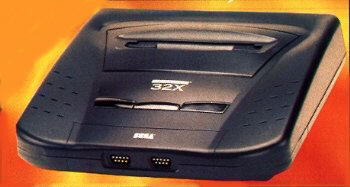
Sega
Neptune
The European market got their own version of the Genesis 32x, imaginatively called the Mega Drive 32x. The Mega Drive 32x has a library of 27 games, including FIFA Soccer and DarXide, neither of which was ever released in the United States. Japan was home to the Super 32x and a library of 18 games. Koei’s Sangokushi 4 (better known as Romance of the Three Kingdoms 4) is the sole exclusive Japanese release.
Unfortunately, all was not well in the land of Sega. The trouble began with those dammed metal clips that attached to the Genesis and protected it from electromagnetic interference. The clips were small, flimsy, and very difficult to attach correctly. Sega’s advertising implied that the 32x simply plugged into the Genesis and did not specifically mention the clips, connection cord, or additional power supply (all of which were included with the 32x unit.) In truth, the 32x really isn’t very difficult to set up correctly with a little practice, but few parents are patient on Christmas morning when surrounded by noisy, whining children. The 32x really doesn’t even need the metal clips to operate correctly, but Sega was not allowed to divulge this information (FCC regulations), plus you run the risk of your game freezing up if an 18 wheeler goes by your dwelling while you are playing. Additionally, Sega began to receive numerous complaints from consumers who couldn’t get the 32x to work correctly with their older Genesis models, prompting Sega to publish a set of simplified installation instructions. A few unlucky souls discovered that the 32x simply wasn’t compatible with some older television sets and that they had to buy an adapter to make it work correctly.
The situation began to deteriorate. Many stores saw large returns of the 32x and its software. Sales of the hardware slowed dramatically. The videogame press got a look at the next wave of 32x titles, and they were not impressed. Many of the upcoming games were either mildly upgraded Genesis ports (Mortal Kombat 2, NBA Jam) or just plain bad (BC Racers, Zaxxon’s Motherbase 2000.) Some pundits even began to refer to the 32x as the “Super Nintendo upgrade", claiming that the 32x merely boosted the Genesis up to SNES standards. Even arcade-perfect ports of classic Sega games like Afterburner and Space Harrier were ridiculed as being old-fashioned and technologically boring. Sega responded by cutting the price of the hardware several times and began to include a pack-in game with the purchase of the unit.
Sega announced that the Saturn would be coming to the United States at the beginning of September 1995, dubbed “Saturn-Day.” Sony’s new Playstation was scheduled for release a mere 20 days later. Sega then surprised everyone by shipping the Saturn and some hurriedly finished software to select stores at the beginning of May, a whopping 4 months ahead of schedule. Sega was now stuck in the curious predicament of having to advertise and support FIVE separate consoles- the Genesis, Sega CD, 32x, Saturn, and Game Gear. Additionally, the Nomad handheld and the Pico educational computer were coming down the development pipeline. Something had to give.
According to Steven
L. Kent's The First Quarter: A 25-Year History of Video Games, Electronic
Arts founder and 3DO guru had this to say about Sega's marketing plans:
| Sega is sending a very confusing message to the customer saying: "Buy Genesis," "now it's Game Gear," "no, actually it's Sega CD," "no, it's 32x," "forget all of that stuff, it's Saturn," "maybe it's Titan," "how about Pico." |
As 32x sales slowed,
so did game development. Many games that were well beyond the planning
stages were either transferred over to the Saturn or cancelled completely,
with a few developers turning over their unfinished 32x games over to Sega
for completion and production. Sega postponed, then cancelled the introduction
of the Neptune hybrid and moved most of their resources over to the Saturn,
even though they publicly stated that the 32x was still an important product.
Games began to come out at a much slower rate, and they received little
advertising. One exception was the stellar 32x conversion of Virtua
Fighter. Sega advertised the game rather heavily (with the tag
line “Patience is a Virtua”), even going so far as to release a promotional
Virtua
Fighter Training Pack that included a how-to video, a T-shirt,
and a sweepstakes entry form, but no cartridge. The Training Pack
is a very rare find today.
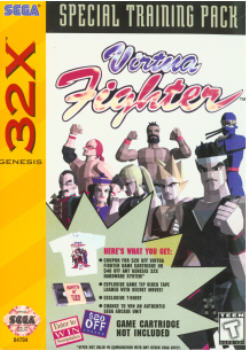 |
|
|
The final nail in the 32x coffin was delivered by toy behemoth Toys R’ Us when they excluded the 32x from their 1995 Christmas catalog, effectively announcing the end of the 32x market. Spiderman: Web of Fire was the last domestic game released for the 32x, and it is very difficult to find today, a victim of limited production. Frontier Development’s DarXide was the final 32x game and was only released in Europe, again in limited quantities. Prices for the remaining inventories of 32x stock were slashed, with the $159.99 console going for less than $20, and the $69.95 game cartridges going for less than $10 each. The system had performed even more poorly overseas, and production was ceased all over the world. The 32x was dead, its name synonymous with failure.
The entire 32x library (including the 3 games not released in the United States) consists of a mere 39 titles. There are no role playing games, unless you count the strategy-intensive Romance of the Three Kingdoms 4 (whose text is written entirely in Japanese.) At least half of the available 32x games are based on previous 16-bit releases form the Genesis and Super Nintendo. Two unfinished games have been found (X-Men and Virtual Hamster), and numerous others are rumored to exist. Both 32x hardware and software is cheap and easy to find in today's marketplace, a victim of overproduction and low sales.
The years have not
been kind to Sega. The Sega CD and the 32x debacle cost Sega a lot of credibility,
and they have never fully recovered. The Saturn was far from the hit that
Sega had hoped for, selling around 2 million consoles in the United States
before its death in 1998, though it performed much better in Japan. The
Game Gear lost its battle against the omnipotent Gameboy, and its Nomad
handheld came and went quickly. The Dreamcast, though a far better machine
than either the 32x or the Saturn, lasted only 2 years before its premature
death. Sega has now left the hardware market and will concentrate
on what it has always does best... game design and development. One cannot
help but look back and speculate how things might have turned out had Sega
. Would the Saturn have been more successful had Sega not introduced the
32x? Is there any way that Sega could have made the 32x a hit? These
questions are subject to debate. Whatever the case, Sega is a fascinating
company, with a rich and exciting history. The 32x will take its rightful
(if ignominious) place in Sega history, never to be completely forgotten.
